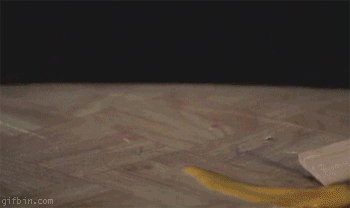Actually, even on a 'technically not impossible' level... I don't think this is possible, even under the '.0000000000000000000000000000000000000000000000001% probability' type of stuff... I don't think it has any probability at all. I think it's 0 probability exactly (without some sort of magic force not indicated in the video)
So... first of all... gravity. At the end of the video, the egg spontaneously gains a huge amount of kinetic energy and flies upward. In real life, this energy was initially dissipated on impact, but gravity was still pulling the egg downwards after impact. The egg sped up towards impact. In the fake world, the gravity would pull upwards instead of downwards, so the the part where only the bottom is cracked kinda makes sense... maybe... But then the egg gets a huge boost of speed, which the table simply could not give it, and then slows down... so that doesn't track with upward-facing gravity. So maybe gravity pulls downward in Fake World like it does in the real world. But then the slow sag when the bottom of the egg is cracked would be there, rather than the slow raise that you see in Fake World.
Then there's the spring. There's nothing pushing the spring backwards in Fake World. You may claim that it's the egg, but the egg isn't pushing on it when it begins resetting.
Then of course there's the other forces inside the egg: momentum, cohesiveness, adhesiveness, internal pressure, a million other factors.
So... because of that, even if all the pieces spontaneously had the exact same state (position and velocity) as they do in the beginning of the Fake World snapshot, it would not end in the same state.
Can any one state in the image spontaneously exist? Sure. Maybe. Again, probably with magic, but whatever. Any one state in the image has an extremely small probability of existing, but we wouldn't be surprised by any one state existing (Every one of those states has indeed existed at least once! Well... the reverse of each state. But still.), and could probably be recreated. And the next ten nanosecond states would probably exist in a reasonable approximation to the original, but would not be precisely exactly the same as the original. But if you set it all up exactly the same way as the end state, but in reverse, with 0 randomness, you would not end up with a whole egg flying upwards at the end of it.
Now... can a broken egg become a whole egg 'spontaneously' (NOT like in the image). Sure. Maybe... Define 'spontaneous'? Foreseeable-future technology probably has a way to glue an egg back together with egg-like substance and make it look like it was never broken in the first place. Food replicators. Do these count as spontaneous? I think so. It's the series of random events that made humans get smart and start inventing things and become humans. That's spontaneous. Personally, I think every thing humans do is as about as natural as termites destroying a house or a tree. It's all the result of a big chain of random events.
Can a broken egg become a whole egg in mid-air without anything touching it (or without anything touching it besides what's in that picture), without magic or nanobots or metal inside the egg and a magnet outside or some other unseen force. No. The events of that image are impossible without some unseen/unknown force.

